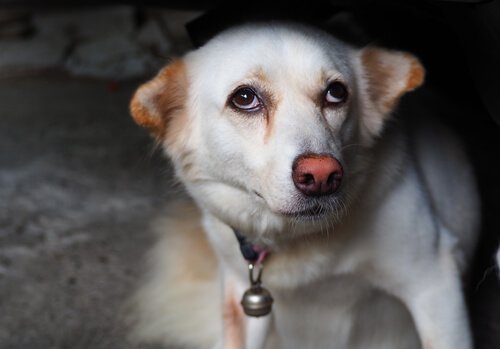How to Calm Your Dog During a Storm

Many dogs have a phobia of loud noises. You can alleviate a lot of your dog’s fear and stress by training him well and providing a place where he can feel safe.
Storm phobia can get your pet scared and stressed out, which in turn can put his health at risk. Follow these tips to learn how to calm down your dog during a storm and get through this difficult situation.
How to know if your dog is afraid of storms
Sounds and lights that cause your dog to feel fear and anxiety are not yet officially classified by veterinarians. Here are the most common things that your pet may react to:
- The sound of wind
- Thunder
- Lightning
- Changes in atmospheric pressure
- Static electricity
- Low frequency sounds before storms that humans cannot hear

Ways to calm down your dog during a storm
The main problem with untreated or undiagnosed phobias is that, each time the trigger reappears, the aggressive, anxious or instinctive response is repeated more intensely.
Fear and anxiety attacks can change your dog’s personality in the long run if you do nothing to control them. A dog who used to be a healthy, obedient and sociable can become a fearful and aggressive animal that no longer obeys his owner.

With the following strategies, you can calm down your dog in the long run and come up with certain action plans for when your dog gets scared and stressed out in the future.
- Try to introduce a “calm down” command into your pet’s training routine. This strategy can be put into effect while your dog is a puppy, and it will have long-term effects. If you teach him that by remaining still and calm, he will get a treat out of it and will relate it to a pleasant experience. That way, you can command your dog to remain calm during a storm.
- Give your dog a place to take refuge. It doesn’t have to only be a shelter. It can be any room where your pet feels comfortable; one that provides him a sense of peace and well-being. If you have a safe-place nearby during a storm, the dog will be able to manage his emotions better.
- Consider giving him a special anti-anxiety garment. Several studies show that receiving hugs during times of stress or anxiety reduces people’s stress levels. When it comes to dogs, you won’t give them hugs, but rather garments tight enough to provide a healthy pressure on their chest and back. A study from 2009 showed its effectiveness for relieving a dog’s anxiety.
Many dogs have a phobia of loud noises. You can alleviate a lot of your dog’s fear and stress by training him well and providing a place where he can feel safe.
Storm phobia can get your pet scared and stressed out, which in turn can put his health at risk. Follow these tips to learn how to calm down your dog during a storm and get through this difficult situation.
How to know if your dog is afraid of storms
Sounds and lights that cause your dog to feel fear and anxiety are not yet officially classified by veterinarians. Here are the most common things that your pet may react to:
- The sound of wind
- Thunder
- Lightning
- Changes in atmospheric pressure
- Static electricity
- Low frequency sounds before storms that humans cannot hear

Ways to calm down your dog during a storm
The main problem with untreated or undiagnosed phobias is that, each time the trigger reappears, the aggressive, anxious or instinctive response is repeated more intensely.
Fear and anxiety attacks can change your dog’s personality in the long run if you do nothing to control them. A dog who used to be a healthy, obedient and sociable can become a fearful and aggressive animal that no longer obeys his owner.

With the following strategies, you can calm down your dog in the long run and come up with certain action plans for when your dog gets scared and stressed out in the future.
- Try to introduce a “calm down” command into your pet’s training routine. This strategy can be put into effect while your dog is a puppy, and it will have long-term effects. If you teach him that by remaining still and calm, he will get a treat out of it and will relate it to a pleasant experience. That way, you can command your dog to remain calm during a storm.
- Give your dog a place to take refuge. It doesn’t have to only be a shelter. It can be any room where your pet feels comfortable; one that provides him a sense of peace and well-being. If you have a safe-place nearby during a storm, the dog will be able to manage his emotions better.
- Consider giving him a special anti-anxiety garment. Several studies show that receiving hugs during times of stress or anxiety reduces people’s stress levels. When it comes to dogs, you won’t give them hugs, but rather garments tight enough to provide a healthy pressure on their chest and back. A study from 2009 showed its effectiveness for relieving a dog’s anxiety.
This text is provided for informational purposes only and does not replace consultation with a professional. If in doubt, consult your specialist.







